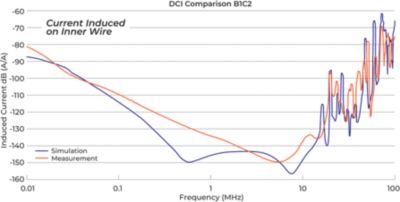-
-
学生向け無料ソフトウェアにアクセス
Ansysは次世代の技術者を支援します
学生は、世界クラスのシミュレーションソフトウェアに無料でアクセスできます。
-
今すぐAnsysに接続!
未来をデザインする
Ansysに接続して、シミュレーションが次のブレークスルーにどのように貢献できるかを確認してください。
国および地域
無料トライアル
製品およびサービス
リソースとトレーニング
当社について
Back
製品およびサービス
ANSYS ADVANTAGE MAGAZINE
DECEMBER 2021
They say you never know when lightning will strike.
Though that expression is mostly used metaphorically to describe an innovative idea, lightning strikes are a very real concern for aircraft manufacturers and aviation regulators, especially considering that a commercial plane is likely to be struck by lightning once every 1,000 hours of flight time. Some aircraft manufacturers have their own innovative ideas on how to understand the effects of those strikes.

European aerospace pioneer Airbus recently used Ansys EMA3D and MHARNESS to simulate lightning susceptibility for a hybrid cockpit design made partially of metal, carbon fiber composite, and copper foil. The simulation was part of a research and technology project focused on developing the aircraft of the future: an ultra-green and highly cost-efficient air-transport system.
Specifically, Airbus engineers wanted to validate how well the model could predict the entire electromagnetic behavior of the cockpit’s complex electronics and cabling system in response to induced transients. That would help them understand how closely simulation results matched the results of field testing.
A COMPLEMENT TO PHYSICAL TESTING
A single lightning strike can contain millions of volts or hundreds of kiloamps. When a force that powerful is injected into an airplane, it has the potential to cause tremendous damage. Lightning strikes can ignite flammable vapors, melt metallic parts, puncture and delaminate composite parts, and disturb the normal operation of safety- and mission-critical systems, including electrical and electronic equipment. At its worst, lightning has brought down commercial aircraft, although that’s exceedingly rare. The last major incident was decades ago.
To promote overall flight safety, aircraft manufacturers design lightning protection into every plane.
Electromagnetic model from the digital mock-up of the cockpit
Evaluating the effectiveness of those features generally centers on physical testing of parts and components — not the entire aircraft. This is mainly because full-threat physical testing of an entire aircraft is available only at a handful of facilities, and the process is difficult, destructive, and dangerous.
Cost and development delays also factor in to physical testing. For one thing, full physical testing of an aircraft under development requires manufacturing a prototype, which takes months and is expensive. If the aircraft fails the test at this point, redesign and retrofit costs can be in the millions of euros.
Fully testing an existing aircraft after changes to its lightning protection systems is also possible, but that process has its own challenges. Every day of testing an aircraft is a day it’s not performing its intended function, flying passengers or cargo to their destinations. That’s an expensive proposition as well.
And, more than once, full-threat testing has caused enough damage to take an airplane out of service for an extended period.
Simulation avoids these challenges, but it is not meant to replace physical testing. Instead, it is an increasingly important tool that contributes to aircraft development as early as the proof-of-concept phase. In addition to helping produce robust designs, simulation also supports the qualification and certification process, as well as aircraft maintainability and modifications.
Cockpit meshed model
SIMPLE, LIGHT, AND MANAGEABLE
Airbus has used Ansys EMA3D to understand lightning-induced electromagnetic compatibility (EMC) and support EMC certification for at least two decades. The solver allows engineers to model large aircraft while also resolving conductor pins no more than a millimeter — or less — in size.
In this case, Airbus compared Ansys EMA3D results to those produced by a complete lightning indirect effect (LIE) and high-intensity radiated field (HIRF) campaign (including low-level direct drive, low-level swept current and low-level swept fields) at its testing facilities in Getafe, Spain. The test cockpit was equipped with a realistic electrical installation, including several metal boxes as dummy equipment and over-braided harnesses with inner conductors.
Surface current distribution on the cockpit
Airbus then used a simple, light, and manageable EM model to perform the simulations. The Ansys EMA3D quasi-magnetic time step acceleration technique increased the permittivity of free space to accelerate the convergence of long transients, making it possible to reduce the speed of light without significantly affecting field values. In fact, EMA3D allowed engineers to select a time step several orders of magnitude higher than the one required by the Courant criterion for the real speed of the light. This is particularly useful in lightning simulations where engineers are interested not only in the peak amplitude but also in the energy content of the response or to solve slow waveforms.
Ultimately, the acceleration technique decreased the number of steps required to design the simulation, reducing simulation time by 90% and speeding the overall process.

The direct current simulation (blue) closely matched the test measurement (red).
A SAFER PRODUCT
Airbus engineers found a high level of agreement between measured results and simulation. The simulation results were actually on the conservative side, making them useful not just for informing design decisions but also for meeting safety and certification criteria.
Using Ansys EMA3D, engineers did not have to tune the electromagnetic model to validate any of the different testing techniques. They were able to consider all of the relevant components, ensure the necessary contact between components and avoid unwanted connections.
In the end, the field study and simulation covered all of the main external threats that can affect an aircraft. The agreement between the two efforts proved the effectiveness of simulation and Ansys EMA3D’s predictive capacity. Now, aircraft manufacturers can be more confident than ever in the ability of simulation to estimate transients induced in the aircraft at every stage in the product life cycle, from the beginning of the design process to qualification and certification, and also during ongoing maintenance.
As for the flying public, this means that if lightning ever does strike, they can rest assured knowing safety has been engineered into every inch of the aircraft.
For more information, visit the Ansys EMA3D Cable and EMA site.
さあ、始めましょう
エンジニアリング課題に直面している場合は、当社のチームが支援します。豊富な経験と革新へのコミットメントを持つ当社に、ぜひご連絡ください。協力して、エンジニアリングの障害を成長と成功の機会に変えましょう。ぜひ今すぐお問い合わせください。